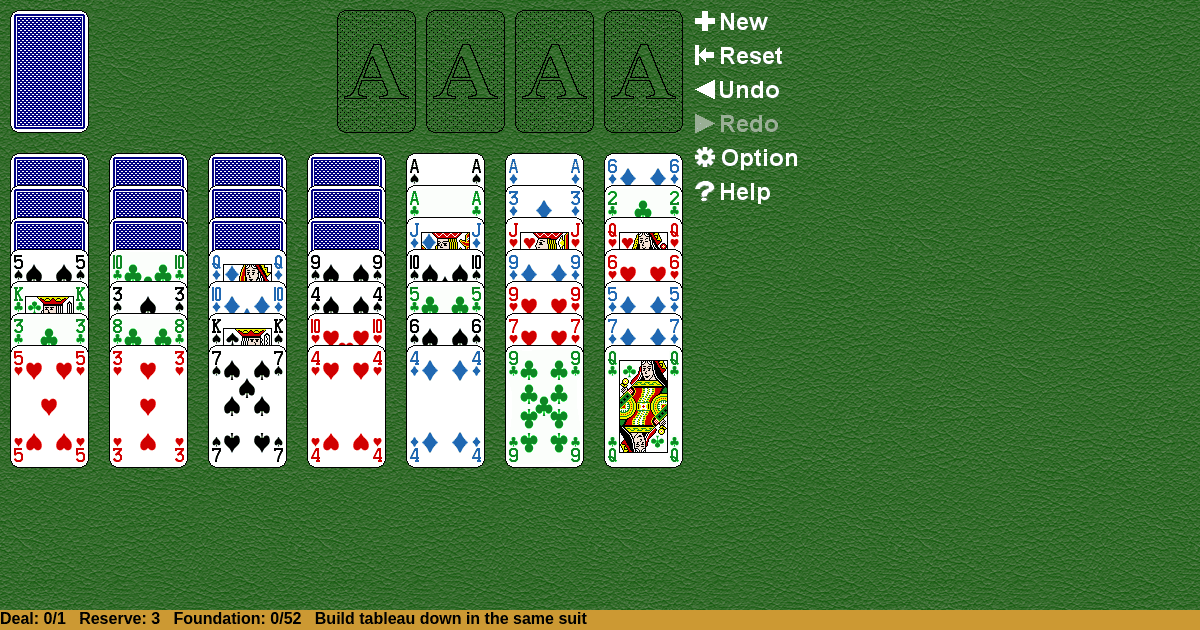Scorpion
Home |
How to play |
FAQ |
About
How to play Scorpion?
Game Objective:
The primary goal in Scorpion Solitaire is to build four complete sequences in the tableau, each consisting of all thirteen cards of a single suit arranged in descending order from King down to Ace.
Setup & Layout:
- Deck: Use a standard 52-card deck.
- Tableau: Deal seven columns (piles), each with seven cards, to form the tableau (the main play area):
- Columns 1–4: Deal the first four cards of each column face down, then three cards face up on top of them (total: 4 face down + 3 face up per column).
- Columns 5–7: Deal all seven cards face up in each column.
- Reserve (Stock): Place the remaining three cards face down in a single pile, usually at the top left of the tableau. This is known as the reserve or "Scorpion tail".
- Foundations: There are no separate foundation piles at the start. Completed suit sequences (King to Ace) are cleared from the tableau to the foundation area as they are built.
Key Play Areas:
- Tableau: The seven columns where all gameplay occurs.
- Reserve: The pile of three face-down cards to be introduced later.
- Foundation: Area where completed suit sequences are moved (not used until a full suit run is built).
Scorpion Solitaire Rules:
- Building Sequences:
- Cards are built down in suit on the tableau (e.g., 9♠ can be placed on 10♠).
- Only cards of the same suit and in descending rank may be placed on each other.
- Card Movement:
- Any face-up card in a tableau column may be moved, along with all cards stacked on top of it (regardless of their order or suit).
- When moving a card, you must move it together with all cards above it as a unit.
- You cannot move partial stacks; only a card and all cards above it can be moved together.
- Turning Cards Face Up:
- When a face-down card becomes the top card of a column (i.e., all cards above it have been moved), immediately turn it face up.
- Empty Columns:
- Only a King or a group of cards headed by a King can be moved into an empty tableau column.
- Reserve Cards:
- When no more moves are possible (or at any time, depending on house rules), deal the three reserve cards face up onto the first three tableau columns (one card per column).
Gameplay:
- Initial Moves:
- Examine the tableau for possible moves, building down in suit by moving cards or groups of cards as allowed.
- Expose and turn face up any face-down cards that become uncovered.
- Moving Sequences:
- Move any face-up card (and all cards above it) onto a card of the same suit and one rank higher in another column.
- Continue building descending suit sequences and consolidating cards as much as possible.
- Filling Spaces:
- If a tableau column becomes empty, fill it only with a King or a group of cards starting with a King.
- Using the Reserve:
- When no further moves can be made (or at your discretion), deal the three reserve cards face up onto the first three tableau columns (leftmost columns).
- Resume play with the new cards in play.
- Completing Sequences:
- When a full suit sequence from King down to Ace is formed in a single column, it is considered complete and may be moved to the foundation area (or simply left undisturbed if not blocking other moves).
- No More Moves:
- If no legal moves remain after dealing the reserve, the game ends.
Winning & Losing Conditions:
- Winning Condition:
- The game is won when all four suit sequences from King down to Ace are built in the tableau and moved to the foundation area.
- Losing/Unwinnable Condition:
- The game is lost or unwinnable if, after dealing the reserve cards, no further legal moves can be made and not all four suit sequences have been completed.
Special Rules & Edge Cases:
- Filling Empty Columns:
- Only a King or a group of cards headed by a King can be placed in an empty tableau column.
- In some relaxed variants, any card may fill an empty space, but this is not standard for Scorpion Solitaire.
- Sequence Movement:
- Any face-up card and all cards above it (regardless of order or suit) may be moved together, but the destination must allow for a legal build (down in suit).
- Dealing Reserve Cards:
- The three reserve cards are dealt only once, and only to the first three columns. No further redeals are allowed.
- Face-Down Cards:
- Always turn face-down cards face up immediately when they become the top card of a column.
- Completed Sequences:
- Once a King-to-Ace sequence in the same suit is completed, it is generally left undisturbed unless it blocks access to face-down cards.
- No Foundations at Start:
- Unlike Klondike or Spider, foundations are not built from the beginning; only completed sequences are moved to the foundation area.
Note: Scorpion Solitaire is considered a challenging solitaire variant, and winning is rare under standard rules.

Solitaire Collection
About Scorpion
Rate (Scorpion)
4.7 / 5
1,916 votes



























































